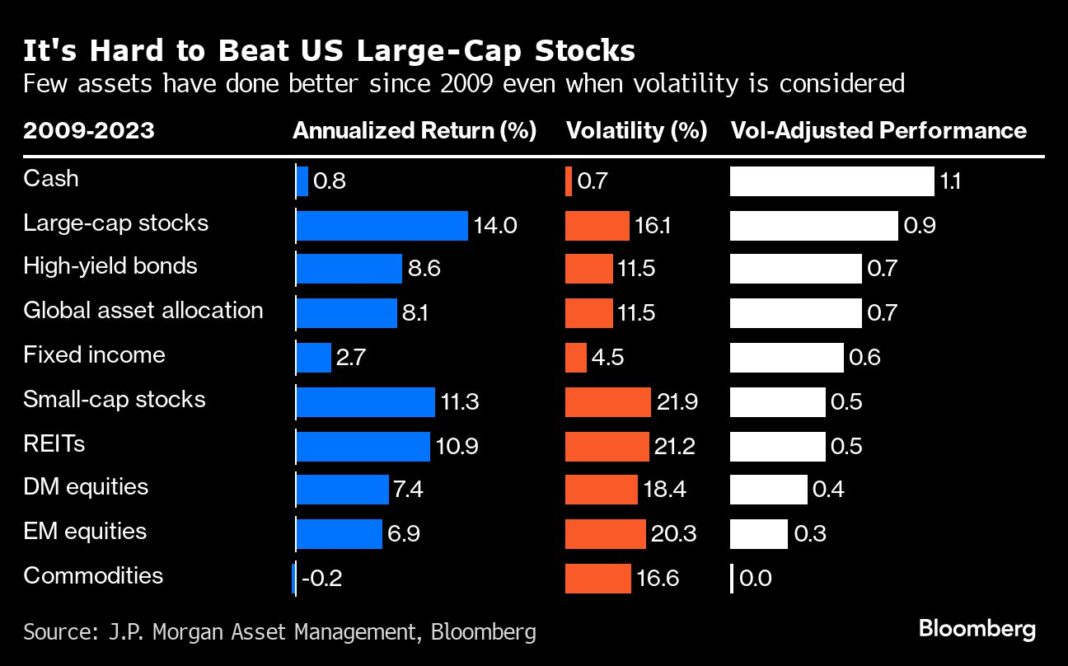‘Missing Out’
Against this backdrop, nearly everyone straying from U.S. equities is subject to a sense of missing out. Over the last 15 years, the PIMCO StocksPLUS Long Duration Fund (PSLDX) is the one and only among the 372 asset allocation portfolios tracked by Morningstar that’s ahead of the S&P 500.
The data has emboldened those who say diversification — however sound in theory — is costing investors over the long run, by holding underperforming investments. The revolt got an airing last year when academics published a study saying retirees would be better off eschewing bonds completely.
Proponents of modern-day allocations pushed back, saying assets like fixed income allow individual investors to better match financial gains with future obligations. Moreover, diversified portfolios won out from 2000 to 2008, a period when stocks saw their values cut in half on two separate occasions.
“Diversification is your best friend on your worst day,” said David Kelly, chief global strategist at J.P. Morgan Asset Management. “The right asset allocation is a little bit like home insurance. You never know when you’re going to need it, but you should never feel comfortable not having it.”
That logic is partly what’s behind the decision by many big-money pros, who periodically shuffle holdings in order to return to a desired level of asset allocation.
Of course, pure returns are not the only thing that matters. Another consideration is how much turbulence must be endured in order to earn the profit. Based on a measure of risk-adjusted returns known as the Sharpe ratio, Cambria’s global asset allocation model has indeed done better than the S&P 500 since 1927.
The Fed’s Impact
But things started to shift after the Federal Reserve rushed to the market’s rescue during the 2008 crisis. Since then, the S&P 500 has staged an almost uninterrupted rally with largely subdued volatility, scoring a higher Sharpe ratio.
“The question everyone has is, does it make sense to diversify?” said Mayukh Poddar, senior portfolio manager at Altfest Personal Wealth Management. “A lot of people have become more focused on equity market returns in the post-Covid era.”
Within diversified portfolios, many clients are growing skeptical over the benefit of investing in small-cap and non-U.S. stocks, according to Que Nguyen, chief investment officer of equity strategies at Research Affiliates.
“What we’ve seen over the last 15 years is that the big gets bigger,” she said. “You don’t want all of your eggs in one basket, but it’s hard to keep the faith.”
In some circles, fixed income’s haven status is questioned too, after the asset class sank together with stocks during 2022’s inflation-induced selloff.

Inflation is likely to stay sticky, making bonds exposed at a time when the government ramps up Treasury supply to meet fiscal needs, according to David Rogal, a portfolio manager at BlackRock Inc.
“It’s very clear that the bond market has become less reliable as a hedge in a portfolio,” Rogal said in a recent panel discussion hosted by MacroMinds Foundation.
It’s tempting to call an end to the equity rally, given the prospect of stretched valuations and restrictive monetary policy. Yet the S&P 500 has kept its leadership this year, delivering a gain that’s again ahead of the rest of the world and contrasts with losses in Treasuries.
There are signs that American investors are adapting to the new regime, including a deepening home bias and a willingness to let equity holdings swell to records, according to Cambria’s Faber. Meanwhile, big-money managers are shifting to alternative assets such as privately held firms as a way to juice up performance.
“There’s no end-expiration date on this” equity boom, Faber said. “Institutions have been leaning hard into this, but the savior that they’re looking for is private equity, which is essentially U.S. stocks.”
(Photo of Meb Faber; credit: Bloomberg)


